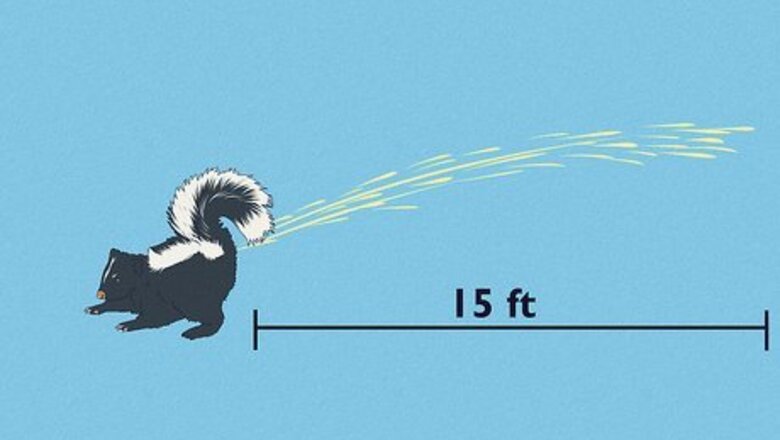
views
- Most skunks can accurately spray from about 15 ft (4.6 m) away.
- Skunk spray can travel very far when it’s windy, so you might smell it up to 1 mi (1.6 km) away.
- Skunks can only spray about 5 to 6 times in a row, and their spray is their only defense against predators, so they don’t want to spray you.
- A skunk will only spray you if it feels threatened, so quietly walk away from a skunk if you encounter one in the wild.
How far can skunks spray?
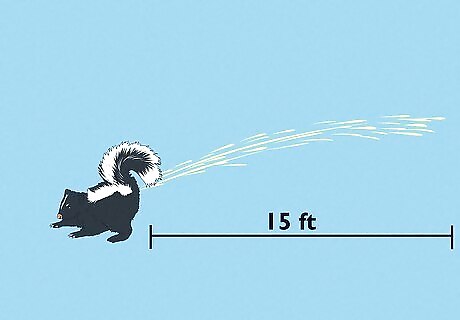
Skunks can spray accurately from up to 15 ft (4.6 m) away. They emit their spray from glands near their anus, which spew out an oily yellow substance. They’re pretty accurate, so you don’t want to be in their crosshairs. Skunk’s can hit targets up to 20 ft (6.1 m) away, but at that distance, their aim isn’t likely to be accurate (which means you probably won't get hit!). The skunk has to turn around to spray you, but that doesn’t mean it doesn’t have good aim.
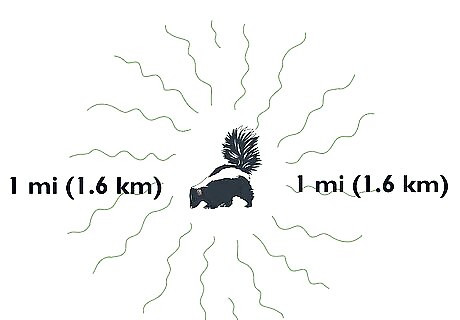
The smell from a skunk can spread up to 1 mi (1.6 km) away. While the spray itself only travels about 20 ft (6.1 m) max, the horrible smell travels even further. The scent particles float with the wind and cover a much wider area. The scent will be faint the further away you get from where the skunk sprayed, but it’s still unpleasant.
How long does skunk odor last?
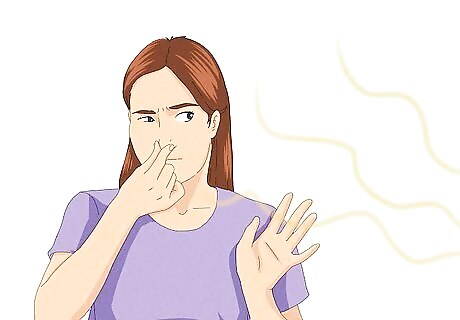
The odor from skunk spray lingers for about 2 to 3 weeks. Unlike your favorite perfume, skunk spray has great staying power. You’ll smell it for days and weeks to come. In fact, humidity can even revive the scent after it dissipates away. On the brightside, your nose might get used to the odor after a while.
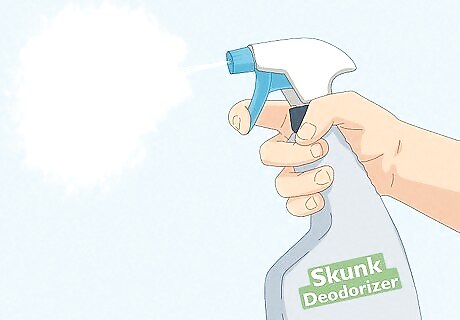
You can speed up the process by using a deodorizer. Skunk spray gets its terrible scent from substances called thiols, which contain stinky sulfur. Fortunately, you can neutralize these thiols so the smell goes away faster. Purchase a skunk deodorizer or make one yourself. To make one, mix the following ingredients in an open container and use the solution immediately: 1 qt (950 mL) of 3% hydrogen peroxide 1/4 cup (45 g) of baking soda 1 to 2 tsp (4.9 to 9.9 mL) of liquid dish soap
How often can skunks spray?
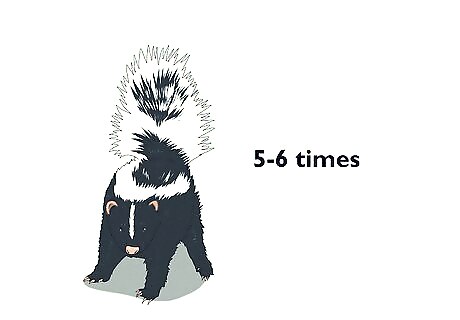
Skunks can spray 5 or 6 times in a row. Typically, skunks hold about 1 tsp (4.9 mL) of skunk spray in their anal glands. Each spray only uses a fraction of the liquid, so the skunk can spray as many as 6 times before it runs out. Usually, a skunk will only spray multiple times in a row if it’s very afraid. Even if you’re trying to help it, the skunk might be very afraid of you.
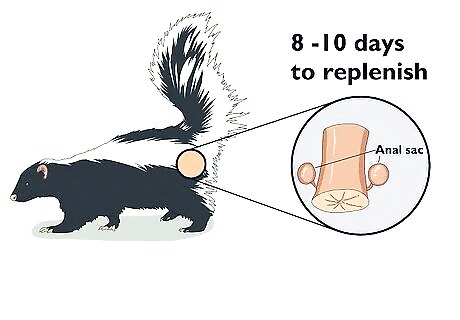
Skunks need 8 to 10 days to replenish their spray. If a skunk empties its anal glands, it’s totally defenseless against predators for over a week. At a minimum, it’ll need 8 days to make more spray. For that reason, skunks don’t spray you just for fun. They’ll try to give you fair warning so that you’ll go away on your own.
Why do skunks spray?

Skunks spray you because they feel threatened. Their spray is their best defense mechanism, and it’s pretty helpful. Most predators won’t approach a skunk unless they’re super hungry because the smell is so bad. If a skunk sprays you, it’s because they thought you were going to hurt them. This is why dogs are likely to get sprayed when they encounter a skunk. A big ol’ dog is scary to a little skunk. The skunk's fear can be real or imagined. You might not even see the little guy before you get misted with eau de stinky butt.
Avoiding Skunk Spray
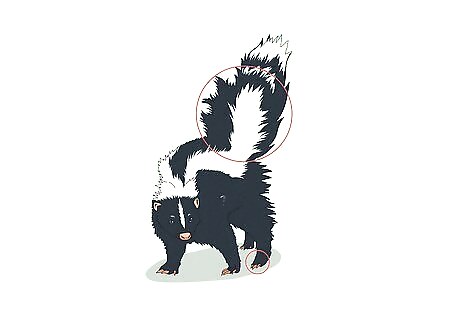
Pay attention to the warning skunk's give before they spray. Skunks want to save their spray because it takes time to replenish it. In the meantime, they’re in danger from possible predators. To give you time to retreat, they’ll stomp their little feet, arch their back, and lift their tail. You might also hear a high-pitched screeching sound. Skunks stomp both of their front feet at the same time, and it sounds like a “tap, tap, tap.” You might also hear grass or leaves crunching.
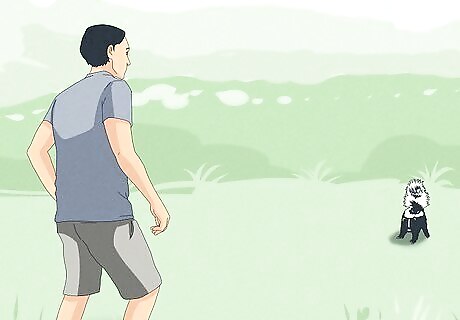
Leave the skunk alone. It’s very unlikely that a skunk will spray you, unless it feels threatened. If you see a skunk, do your best to stay quiet and slow down so the skunk knows you’re not a threat. Then, move slowly away from it so it’s less likely to react. Skunks are afraid of loud noises, so be as quiet as possible.
Dogs & Skunk Spray
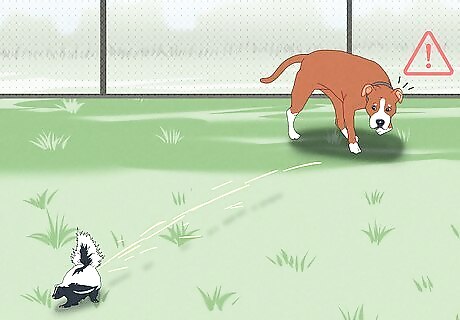
Dogs scare skunks, so they’re more prone to getting sprayed. Your pup is everything a skunk hates. Dogs are a larger animal, and their barks and growls are noisy. Worse, your dog is likely going to want to meet the skunk—and might even mistake it for a toy. A skunk will spray your dog if it’s afraid. Even the friendliest dogs can lunge at skunks. Tell your dog to “heel” or “stay” to stop it from lunging. Before your pup goes out to pee, turn on your outdoor lights and wait a minute. Skunks hate bright lights, so they might skedaddle before encountering your dog. While you should be quiet if you see a skunk, being loud gives them time to run and hide before you meet. If you're walking your dog in wooded areas, make some noise! Skunk spray may cause eye irritation, but it won't cause any lasting harm to your dog.
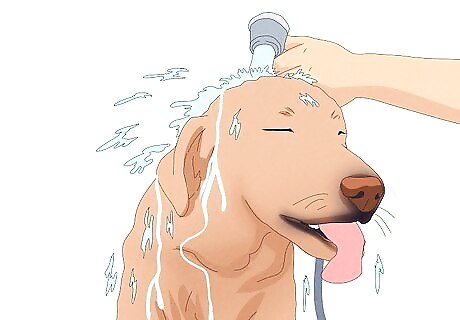
Give your pup a skunk bath to get rid of the odor. Use a skunk shampoo that’s formulated for dogs or make one yourself. It’s safe to use the odor neutralizer we mentioned earlier on your dog. Once you give your pup a quick bath, their smell will improve a ton. To make the odor neutralizer, you mix 1 qt (950 mL) of 3% hydrogen peroxide, 1/4 cup (45 g) of baking soda, and 1 to 2 tsp (4.9 to 9.9 mL) of liquid dish soap in an open container. Use the solution immediately.
Getting Rid of Skunks
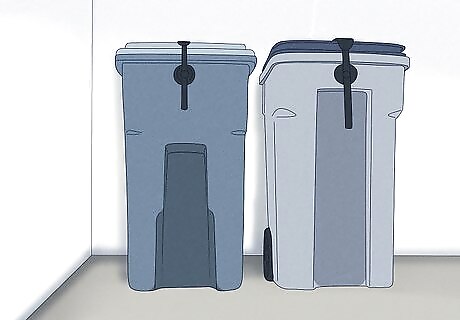
Remove trash and pet food because they attract skunks. Skunks are a lot like raccoons. They love to munch on your trash and steal your pet’s kibble. It’s time to cut off the all-you-can-eat critter buffet outside your home. Start securing your trash can lid to make sure the skunks can’t get inside. Additionally, feed your pets inside or pick up uneaten food after a few minutes. Skunks also dig up bugs to eat, so treat your yard for pests if the skunks don’t go away. Once the skunks realize their food source is gone, they’ll mosey on over to someone else’s trash heap.
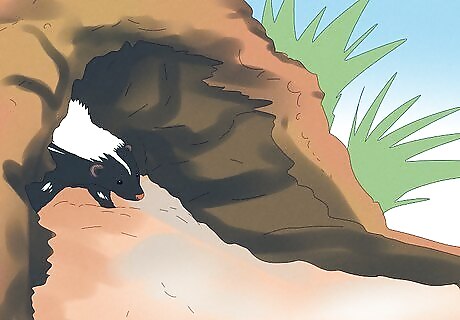
Look for skunk activity under buildings, wood piles, or the ground. Skunks are nocturnal and prefer to live in cramped, dark places. They usually don’t make their own burrows, so they live under homes or sheds, under wood piles, or in other animals’ abandoned burrows. Look for skunks under the buildings on your property. If you can smell skunks but not see them, follow your nose to see if it leads you to a skunk hidey hole.
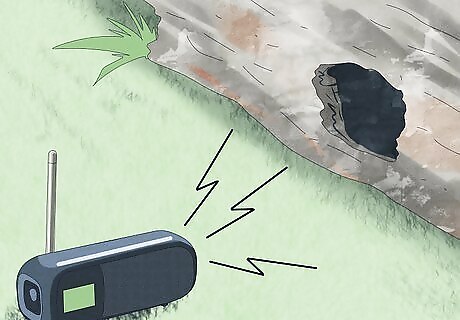
Annoy the skunk with lights and noise until it leaves. Skunks really want to be left alone, so they’ll up and move if you’re bothering them. Use noise and flashing bright lights to irritate the skunk. During the day, shine a flashlight into the skunk’s hidey hole periodically. Additionally, set a radio next to the hole because the sound will bother the skunk. After a few days of your harassment, the skunk will likely move out to pursue a more peaceful home. It’s best to leave the skunk alone during late spring or summer. That’s when skunks have babies, and they need their mother. If you evict the momma skunk, the babies will die. Oh, the smell!

Make sure the skunk is gone before you seal off their hidey hole. Stuff newspaper into all of the open spaces around the skunk’s home. Check the newspaper daily to see if it looks moved. If it’s been disturbed, your skunk is likely still living in its hidey hole. If the paper is still in place, congrats! Your skunk is officially evicted! Keep stuffing the paper into the holes until your skunk is gone.
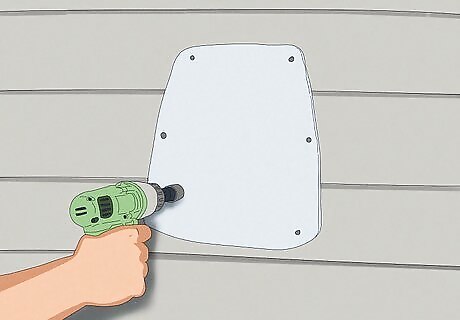
Cover and seal all openings around your home's foundation. Skunks love to live under homes and sheds because they’re very cozy. They’ll make themselves right at home under your porch or under your back stairs. Eliminate their hidey holes by covering them with mesh, wood, plastic, or concrete. For a decorative option, install some lattice work around the base of your home.
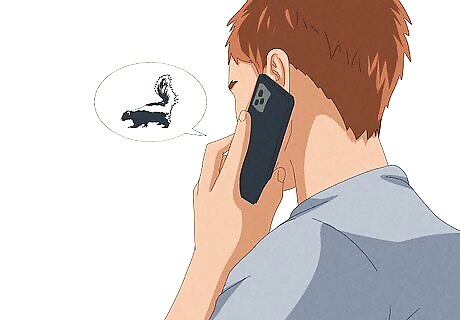
Call a local wildlife pest control operator if the skunk won’t leave. Don’t try to trap a skunk yourself because that’s a recipe for a big, stinky disaster. You’ll likely get sprayed, as will your home. Plus, you can’t legally dispose of a skunk in most areas. Play it safe by calling in an expert pest control operator. Once the skunk is gone, remember to seal off those entryways so another one doesn’t move in.


















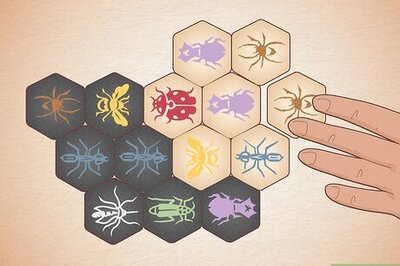
Comments
0 comment